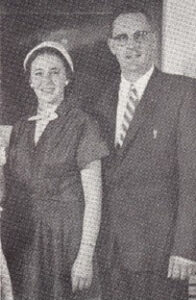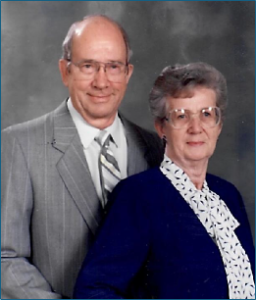Address
795 Island Hwy W.
Parksville, BC, V9P 1B9
Phone
(250)248--6644
Address
795 Island Hwy W.
Parksville, BC, V9P 1B9
Phone
(250)248--6644
This chapter is based on a longer account of Our Saviour Lutheran Church’s earliest history, which is available from the church office for those who would like to know more.
Unfortunately, very little is known about Pastor Alfred Enders’ ministry in Parksville and Coombs. His first visit to this area took place on the day after his ordination and installation in July 1941, when Pastor Doeling (his predecessor) helped him lead a simple worship service in Fred Gulbe’s home in Coombs for a congregation of 7 people.
This was more or less the same pattern Pastor Enders seems to have followed for the next 4 years, until he accepted a call to St. Paul’s Lutheran Church in Chilliwack in 1945. The Lord’s Supper was offered two or three times a year to a tiny handful of communicants. Since Fred Gulbe and his mother Julia hosted the gathering, they were always present. So were the Kaisers, a faithful middle-aged couple. It is likely that other people surrounded this tiny core group and sometimes joined in worship, but the list of members did not grow at all between 1941 and 1946.
In fact, the group shrank when Fred Gulbe, the head of its host family, died in January 1945 at the age of 43. A few months later, Pastor Enders too left the tiny Coombs mission when he accepted the call to Chilliwack. What would happen next?
God provided. On November 25, 1945, the Alberni Parish ordained and installed another new seminary graduate as its next pastor, Rev. Reinhold Goetjen. Within six months, the Coombs mission had welcomed not just one but two new families into its midst! James and Melanie Agesen and their young family were to be “regulars” for more than a decade. The other new couple, Bill and Henrietta August, became vital pillars of the Coombs-Parksville assembly of Lutherans until well into the 1980s.

Granted, this little burst of sudden growth (doubling the mission’s families from two to four!) did not continue. The same four last names appear again and again in the Communion records for the next 12 years: Gulbe, Kaiser, Agesen, and August. Would the Coombs mission ever really take off?
To some extent, yes. After Pastor Goetjen took a call to Creston, the Alberni Parish welcomed Rev. Gordon Schultz as its pastor on Dec. 4, 1949. Like Pastor Doeling years before, Pastor Schultz too had the benefit of several years of pastoral experience. Recognizing the value of Holy Communion, he committed himself to offering it every month in Coombs. For the first few years, the number of communicants remained very low—usually the same six people from the same four families. But then, in 1952, a middle-aged couple named Roy and Hilda Bull were received as communicant members after a period of adult instruction. A few months later, two of their teenage children were also confirmed,
Then, another little breakthrough! In February 1953, an advertisement in the Parksville-Qualicum Progress announced that Lutheran services were being held twice a month at Grace Community Church in Coombs. (Photo at right) This seems to have been the first time that the Lutherans who eventually formed Our Saviour Lutheran Church were able to hold regularly scheduled worship services in a dedicated church building.
Even so, these small steps forward were not enough to make much difference. By the end of 1957, there was still only an average of 7 people receiving Communion in the Coombs mission. The last service recorded in the official church register was held in January 1958. One of the 9 people who took part was Mrs. Kaiser, the last remaining member from Pastor Doeling’s pioneering ministry almost two decades earlier. Five of the other 8 were from the Agesen family, who had joined in 1946. Otherwise, only 3 new family names had appeared in the parish records in the previous 6 years. It must have looked like the writing was on the wall! After 20 years, the time seems to have come to suspend the Parksville-Coombs Lutheran mission.
The demands on Pastor Schultz’s time in Port Alberni itself probably made this decision inevitable. In the previous 8 years he had conducted 27 funerals, performed 102 weddings, baptized 244 children, confirmed 35 youths and 38 adults, and received 57 new members by transfer from other congregations—in Port Alberni alone! He had also been serving that whole time in Courtenay and Campbell River, playing a key role in helping both of those missions become organized as full-fledged congregations in 1957. By comparison, the Coombs mission must have seemed like it was going nowhere. So, for many years, there are no further records of any official Lutheran presence, or formal mission-work, in the Parksville-Coombs area.
What got things going again was the arrival of Pastor Carl Beiderwieden in February 1974. A friendly man with a big smile, he already had 31 years of ministry under his belt. Crucially, the first 15 of those years had been spent as a mission-developer in North Vancouver. It didn’t take him long after his installation as pastor of Grace Lutheran Church in Port Alberni to start resurrecting Lutheran mission-work in the Parksville area.
Under God’s grace, there was still a bit of a base to build upon. Grace Lutheran in Port Alberni had two member families living in Parksville; St. Paul’s Lutheran in Nanaimo had three.

Pastor Beiderwieden’s visits uncovered four more families that were interested in attending services. All he needed was permission to get going! Permission from the Alberta-BC District was no problem. The sticking-point was the Western Regional Committee—a group that helped the major Lutheran denominations coordinate their work. One of its goals was reducing competition in the field so each church could concentrate its efforts where they would be the most effective.
Sensing a vacuum in the Oceanside area, the Lutheran Church in America (LCA) had applied in 1973 for the right to do mission-work in Parksville, Coombs, Qualicum Beach, and Qualicum Bay. Because the ABC District had suspended its work in Coombs so many years earlier, its leaders had agreed to this request. However, the LCA hadn’t really gotten anything going. And now Pastor Beiderwieden was on the scene with missionary expertise, a plan, and a cluster of families that were eager to get going. Would the LCA be willing to give up its rights and let the ABC District move ahead?
The answer, eventually, was “yes.” It took almost two years of negotiations, but in a letter to Pastor Beiderwieden in May 1976, the ABC District president (Rev. Ed Lehman) shared the good news that the Committee had “granted clearance for our church [the ABC District] to work in Parksville and area.”
That was great, because Pastor Beiderwieden had already been busy! In the middle of September 1974, he led a meeting in Parksville for the 9 families that were interested in Lutheran services. The first worship service took place a few weeks later—on Thanksgiving Sunday, October 13, 1974. The location of this service is unknown, but a while later, the pastor reported that services were being held in the Chapel of Pines funeral home. Its owners charged no rent for using what Pastor Beiderwieden called its “very attractive chapel.” That was a blessing, because the average offering at that point was only about $25 per service. That was pretty good for a group that averaged only 18 people in worship. But it was definitely not a strong enough financial foundation to let that little group move ahead very far, or fast, on its own.

Thankfully, Pastor Beiderwieden’s excellent relationship with the ABC District kept the ball rolling. His enthusiasm for Parksville’s potential was infectious. “This district is called the fastest growing community in Canada,” he wrote in June 1976. The previous year, 1975, Parksville’s population was 4,300, but “close to 400 families have moved into Parksville so far this year.” Looking ahead, local authorities were projecting a population of 14,000 by 1985 and 22,000 by 1995.
The ABC District leaders didn’t need much encouragement. Less than two months later, the District’s Executive Secretary, Rev. Les Gierach, encouraged Pastor Beiderwieden to keep moving forward and promised to subsidize an expansion to the work. A few months after that, Pastor
Beiderwieden dashed off a quick letter to District President Lehman asking how to go about buying some land. Prices were shooting up and desirable properties were selling quickly. Within two weeks, District staff told Pastor Beiderwieden to start looking around for a suitable property. The hunt was on!
Nor was that all. A few months later—January 1977—the ABC District encouraged Pastor Beiderwieden’s church in Port Alberni to apply for a vicar (a student pastor) for the 1977-1978 academic year “for the purpose of exploring and intensifying work in Parksville.” The District was already setting aside funds for that work. In May, Grace Lutheran Church was officially informed that Daniel E. Georg, a third-year student at Concordia Theological Seminary in Ft. Wayne, Indiana, was being assigned to serve the Parksville mission between Sept. 1, 1977, and Aug. 31, 1978. Hopes were high that this would turn out to be a big step forward, especially since Vicar Georg had served for a few months the previous summer in another small ABC District mission in Hope, B.C.
Meanwhile, the hunt for a suitable property was also moving ahead. A 4½ acre lot became available on Wembley Road, close to Island Highway. The price was $75,000. The lot already had electrical service and two good wells. Even better, the pastor wrote to Rev. Gierach,
There is a double mobile home on the property and it has been placed on a solid and full concrete basement. […] I don’t know if you are familiar with mobile homes but these double ones are not a makeshift affair. It should provide an adequate parsonage for indefinite years. The property has enough frontage to erect a future church on the road side and, of course, have adequate parking in the rear. If it should happen that the work in Parksville might eventually be dropped, there is little doubt that the investment in this property would be returned.
A loan was quickly arranged. Payments were $500 a month, which was more than 40% of this tiny group’s first budget. Only about 20% of its income in that first year came from its own members. All the rest ($11,445 out of $14,544) would have to be provided—and was provided—by a generous subsidy from the ABC District.
